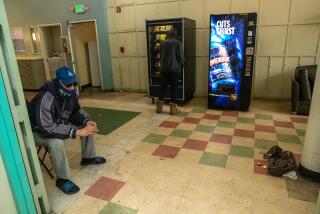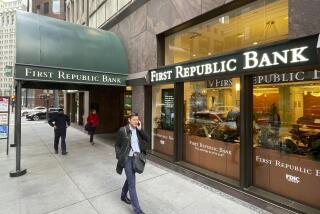Forecast Is Now $3.4 Billion to Liquidate Lincoln Savings : S&L; failure: As estimates climb, taxpayers will pay $800 million more to clean up the defunct Irvine thrift.
Taxpayers will pay $800 million more to clean up Lincoln Savings & Loan, already the nationâs costliest S&L; failure, as continuing expenses and lower purchase prices for its holdings have pushed the cost of liquidating the defunct Irvine thrift to $3.4 billion.
The Resolution Trust Corp., which is disposing of Lincoln, said it has revised its estimate from its original forecast of $2.6 billion made when the agency closed the failed S&L; and sold its deposits to Great Western Bank in Beverly Hills in March, 1991.
The new figure means that regulators now expect to collect only 27 cents on the dollar for Lincolnâs assets, which former operator Charles H. Keating Jr. had valued at $5.4 billion before the institution was seized in April, 1989.
The revised figure is part of internal reports at the RTC, the federal agency that is liquidating the nationâs failed S&Ls;, and was released at the request of The Times.
âWow, that seems a bit higher than I would have expected,â said Bert Ely, a thrift industry consultant in Alexandria, Va.
âIt shows how good Charlie Keating was at doing a bad job,â Ely said. âKeating was a bright guy but had no sense of money, no sense of value. He was just totally out of touch with reality as far as real estate was concerned.â
Keating also defrauded thousands of investors and others. He is serving prison terms for a state securities fraud conviction and a federal racketeering, conspiracy and fraud conviction. The RTC has estimated that the wrongdoing of Keating and others accounts for $962 million of Lincolnâs total loss.
The revised figure, based on a financial review of Lincolnâs liquidation through 1992, was caused by write-downs in the value of remaining land and other assets, lower-than-expected sale prices and additional liquidation costs, said Felisa Neuringer, an RTC spokeswoman.
The agency so far has received 42 cents on the dollar for Lincolnâs real estate holdings, most of it vacant desert land bought for development, and about 48 cents on the dollar for the S&L;âs portfolio of risky high-yield corporate bonds, known as junk bonds.
After Lincoln was seized, the Federal Deposit Insurance Corp. operated the thrift for four months, turning it over to the newly formed RTC in August, 1989.
In those four months, the FDIC sold more than $250 million in assets to cover a run on deposits by customers. It also wrote down holdings by about $1 billion.
The RTC inherited assets that were appraised at $4.2 billion and has since sold about three-quarters of that at a loss of nearly $400 million.
Meantime, the agency--as with all failed thrifts it liquidates--has borrowed unspecified sums to pay for the costs of liquidation, thus incurring additional interest and principal expenses.
As part of its annual report, the RTC revises its loss estimates on every failed thrift that still has assets to sell. Those individual figures arenât published but are available on request. Some estimates on thrifts have lowered, Neuringer said, but Lincolnâs has shot up.
âBy far, itâs the costliest thrift failure ever,â she said. University Savings in Houston is closest, having cost taxpayers $2.58 million, she said.
Keating, former chairman of Lincolnâs parent company, American Continental Corp., has been in prison since April, 1992. His combined state and federal sentences will keep him behind bars for a minimum of 10 years on his federal sentence of 12 years, seven months.
His son, Charles H. Keating III, was sentenced to eight years, one month in prison on his federal racketeering, conspiracy and fraud convictions. Seven others, all of whom pleaded guilty to a reduced number of charges, are expected to be sentenced in November.
Former corporate lawyer Mark S. Sauter is scheduled for sentencing Nov. 8. At the same time, a sentencing date will be set for former American Continental President Judy J. Wischer. On Nov. 22, Keating son-in-law Robert M. Wurzelbacher Jr., a former senior vice president, is to be sentenced.
The remaining four are expected to be sentenced Nov. 29. They are former Lincoln Chairman Robin S. Symes; former Lincoln President Raymond C. Fidel; Bruce Dickson, a former American Continental vice president, and former Arizona developer and Lincoln loan customer Ernest C. Garcia II.
Recovering From Keating
Federal regulators have raised the tax bite of Lincoln Savings & Loanâs failure to 3.4 billion. But taxpayers arenât covering some $285 million that thousands of small investors lost. In this legal wrangling investors might collect nearly 70 cents on the dollar.
Lincoln Settlements
A $1.5 billion judgment against Charles H. Keating, Jr. and two others is all but worthless because they have no money. But investors who sued in class actions are getting most of their money back from lawyers, accountants and others who aided Keatingâs fraud. Amounts in millions
Defendant Settlement Ernst & Young (Arthur Young & Co.) $63.00 Accountants Michael R. Milken and related parties 50.00* Brokers Drexel Burnham Lambert bankruptcy estate 44.90 Brokerage Jones, Day, Reavis & Pogue (Cleveland) 24.00 Law firm Arthur Andersen & Co. 22.85 Accountants Kaye, Scholer, Fierman, Hays & Handler 20.00 Law firm Deloitte & Touche (Touche, Ross & Co.) 7.50 Accountants Parker, Milliken, Clark, OâHara & Samuelian 5.65 Law firm Former Lincoln officials 4.50 Bankers Sidley & Austin 4.00 Law firm All others 9.70 Total $256.10 Distributed to plaintiffs $118.20
* Figure is expected to rise pending the allocation of funds from a settlement of numerous lawsuits against Milken and others.
Legal Fees
The civil court pursuit of Keating and his associates produced huge legal fees and some of the largest recoveries ever, especially for small investors. One group sued separately for $3.6 million. The Resolution Trust Corp. sought $2.6 billion lost in Lincolnâs collapse. Here are the results: Amounts in millions
Recovery per Settlement Legal fees Expenses dollar spent Class actions $256.1* $72.9 $17.8 $3.00 Yahr lawsuit 4.4 .2 .2 3.14 RTC lawsuit 280.0* 17.0 11.5 9.82
*Includes amounts in pending settlements.
Sources: Resolution Trust Corp., Office of Thrift Supervision, Cotchett Illston & Pitre; Researched by JAMES GRANELLI / Los Angeles Times
Asset Sales
In the first four months after it was seized, Lincoln Savings & Loan lost $1 billion as regulators lowered asset values. Then the Resolution Trust Corp. took over, writing down more assets. here is what the RTC has sold, how much it received, how much it lost and how much remains to be sold. Amounts in millions
Value of remaining Type of asset Book value Sale proceeds Losses assets Mortgages $1,015 $925 $90 $440 Securities 1,206 1,121 85 20 Junk bonds 265 128 137 5 Loans 73 45 28 68 Real estate 73 31 42 68 Other 422 409 13 578 Total $3,054 $2,659 $395 $1,179
Collapse of an Industry
Lincoln Savings was joined in its failure by hundreds of other thrifts, leaving taxpayers to foot the bill for the costliest financial debacle in U.S. history. Some key facts from the bailout:
Number of failed thrifts resolved by U.S. government in:
1934-79: 143
1980-87: 284
1988-93: 882
Cost of RTC bailout: $115 billion*
Value of thrift assets sold by RTC: $342 billion
Value of outstanding assets to be sold by RTC: $76.3 billion
Legal fees paid by RTC (1991-93): $857.4 million
Number of pending RTC lawsuits involving thrifts: 256
* Estimate
Sources: Resolution Trust Corp., Office of Thrift Supervision, Cotchett Illston & Pitre; Researched by MATTHEW HELLER / For The Times
More to Read
Inside the business of entertainment
The Wide Shot brings you news, analysis and insights on everything from streaming wars to production â and what it all means for the future.
You may occasionally receive promotional content from the Los Angeles Times.










